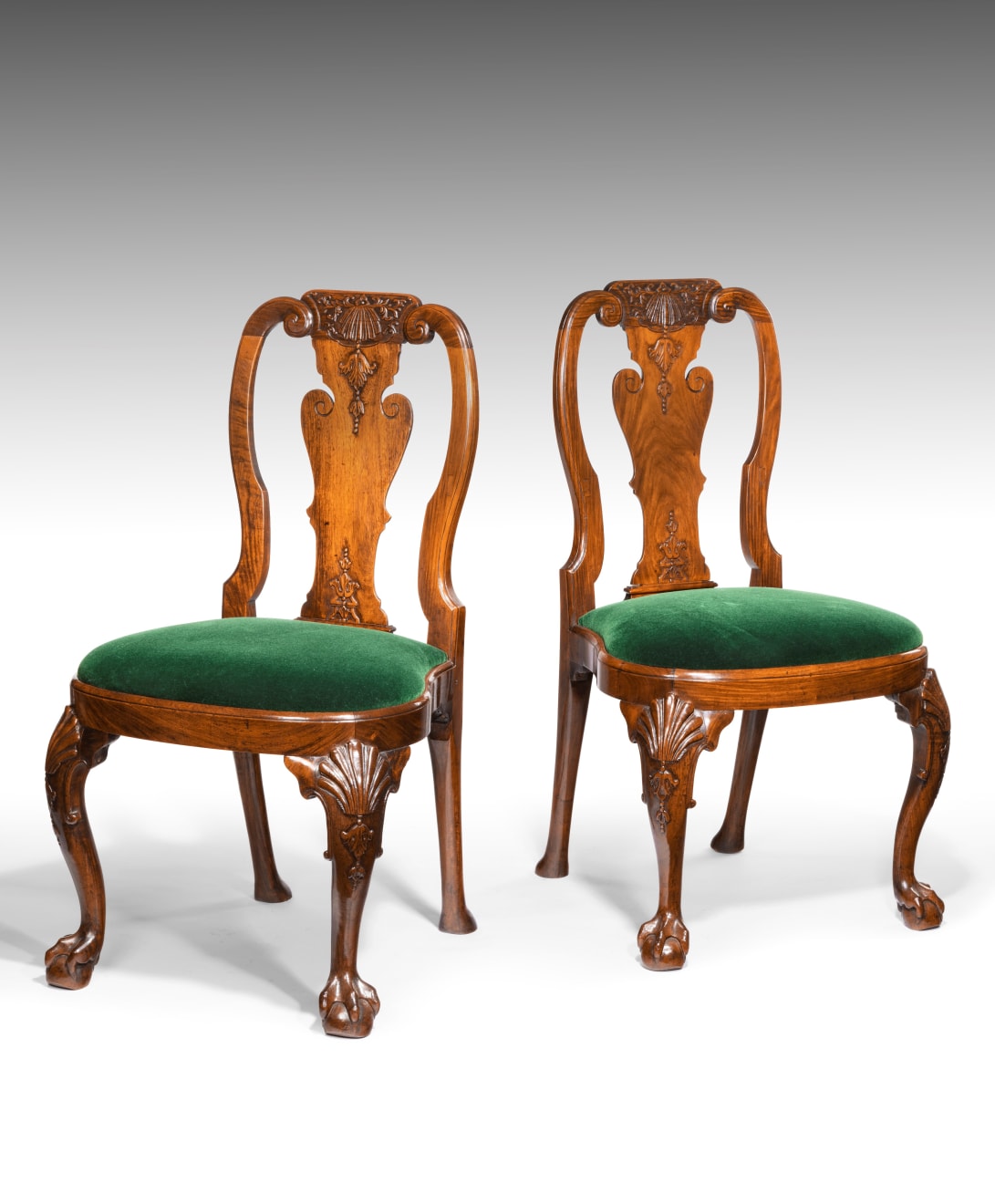Pair of Chinese Export Padouk Side Chairs After a Design by Giles Grendey
41 x 22 1/2 x 22 1/8 in
104 x 57 x 56 cm
104 x 57 x 56 cm
6756
Further images
Provenance
Private Collection, Northern England, reputedly in the same family since 18th Century; the same family have inhabited the house for 400 years.
Each with foliate carved crest rail centred by a shell above a vase-shaped splat carved with pendant foliage and scrolls. With shaped drop-in seats. Supported on cabriole legs carved with...
Each with foliate carved crest rail centred by a shell above a vase-shaped splat carved with pendant foliage and scrolls. With shaped drop-in seats. Supported on cabriole legs carved with shells and pendant foliage, terminating in ball-and-claw feet at the front.
These chairs represent an early example of hardwood furniture which was made to an English design for an export market but was manufactured in Canton. As Carl L. Crossman explains in ‘The Decorative Arts of the China Trade: Paintings, furnishings and exotic curiosities’, such furniture may have been made to special order, perhaps for a member of the British East India Company posted in China or on Macao, another company outpost. Furniture of this type and early date is a rarity as the British East India Company’s ledgers only list a few dozen pieces per year during the 1720s and 1730s.
Crossman illustrates two similar examples of chairs of a similar design in ‘The Decorative Arts of the China Trade: Paintings, furnishings and exotic curiosities’ (Antique Collectors’ Club, 1991), p.231, plate 84 and p.233, plate 85.
A single example of a side chair of this model was sold at Christie’s New York in their ‘Important English Furniture’ sale on 21st October 1999, Lot 174 for $32,200. This chair came from the Columbus Museum of Art, Holmwood Park.
A closely related single armchair was sold in Christie’s New York, ‘Two Distinguished American Collections’ on 4th-5th March 2014, Lot 520.
A pair of side chairs of this model were sold by Christie’s London in their ‘The Property of a Lady’ sale on 14th April 1988, Lot 126.
Adam Bowett illustrates a similar walnut armchair in ‘100 British Chairs’ (Antique Collectors’ Club, 2015), fig. 32, p.52. This walnut armchair is attributed to Giles Grendey.
The chairs’ design is the copy of an English prototype of the same date, which can be attributed to the workshop of cabinet-maker Giles Grendey. A walnut armchair related to this design from the Percival Griffiths Collection, is illustrated in R.W. Symonds’ ‘English Furniture From Charles II to George II’ (The Connoisseur Ltd., London, 1929), p.149, fig.95. This chair was later sold from the collection of Dr. Frank Crozer Knowles, Wynnewood, Pennsylvania at Christie’s New York on 22nd October 1988, lot 243.
Adam Bowett discusses the production of Chinese Export chairs which were made to English designs in ‘Early Georgian Furniture 1715-1740’ (Antique Collectors Club, 2009), pp.47-50. He comments that, from the 1720s, the East India trade began importing ‘rosewood’ furniture made to English patterns. However, ‘[t]he precise identity of the ‘rosewood’ employed in such furniture has been the subject of much connoisseurial and botanical debate…, but the majority appears to have been made from what is now called padouk’ (ibid, p.47). Bowett discusses some examples of Chinese export chairs which survive in English collections.
These chairs represent an early example of hardwood furniture which was made to an English design for an export market but was manufactured in Canton. As Carl L. Crossman explains in ‘The Decorative Arts of the China Trade: Paintings, furnishings and exotic curiosities’, such furniture may have been made to special order, perhaps for a member of the British East India Company posted in China or on Macao, another company outpost. Furniture of this type and early date is a rarity as the British East India Company’s ledgers only list a few dozen pieces per year during the 1720s and 1730s.
Crossman illustrates two similar examples of chairs of a similar design in ‘The Decorative Arts of the China Trade: Paintings, furnishings and exotic curiosities’ (Antique Collectors’ Club, 1991), p.231, plate 84 and p.233, plate 85.
A single example of a side chair of this model was sold at Christie’s New York in their ‘Important English Furniture’ sale on 21st October 1999, Lot 174 for $32,200. This chair came from the Columbus Museum of Art, Holmwood Park.
A closely related single armchair was sold in Christie’s New York, ‘Two Distinguished American Collections’ on 4th-5th March 2014, Lot 520.
A pair of side chairs of this model were sold by Christie’s London in their ‘The Property of a Lady’ sale on 14th April 1988, Lot 126.
Adam Bowett illustrates a similar walnut armchair in ‘100 British Chairs’ (Antique Collectors’ Club, 2015), fig. 32, p.52. This walnut armchair is attributed to Giles Grendey.
The chairs’ design is the copy of an English prototype of the same date, which can be attributed to the workshop of cabinet-maker Giles Grendey. A walnut armchair related to this design from the Percival Griffiths Collection, is illustrated in R.W. Symonds’ ‘English Furniture From Charles II to George II’ (The Connoisseur Ltd., London, 1929), p.149, fig.95. This chair was later sold from the collection of Dr. Frank Crozer Knowles, Wynnewood, Pennsylvania at Christie’s New York on 22nd October 1988, lot 243.
Adam Bowett discusses the production of Chinese Export chairs which were made to English designs in ‘Early Georgian Furniture 1715-1740’ (Antique Collectors Club, 2009), pp.47-50. He comments that, from the 1720s, the East India trade began importing ‘rosewood’ furniture made to English patterns. However, ‘[t]he precise identity of the ‘rosewood’ employed in such furniture has been the subject of much connoisseurial and botanical debate…, but the majority appears to have been made from what is now called padouk’ (ibid, p.47). Bowett discusses some examples of Chinese export chairs which survive in English collections.








